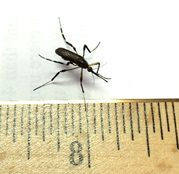What's causing the increase in bug bites that get very big and hot?
Question: A local hospital is seeing an increase in bug bites that get very big and hot. Larger than normal mosquitos have also been seen. What insect may be causing this allergic reaction?
Answer: It is not surprising that with the flood lingering for several months that there would be many more complaints of insect bites from local residents and visitors alike. Most of these are likely various species of mosquitoes sourcing from pools of water, and my guess is attacks will continue until winter and then well into next year, perhaps even for a few more years, until most pools and backwaters have dried up. The larger than normal mosquitoes which you mentioned are likely gallinippers, species Psorophora ciliata.

Being much larger, adult swarms evoke much fear, as they can be vicious in their attacks any time of the day, and they withdraw more blood. Ironically, their larvae are predators of smaller species of mosquito larvae. So, gallinipper larvae are capitalizing on this vast resource of mosquito larvae, but in turn, are multiplying and pestering humans and pets. Some people, especially young children, have stronger allergic reactions to mosquito bites, and they should remain indoors or protect themselves with repellents when active outdoors. And it is obvious that loose clothing should be worn which covers most of the skin surface.
Other insects which may emerge from floodwaters or migrate as floods spread over the land are midges (many species in vast numbers), darkwinged fungus gnats (from wet organic soils), a few species of black flies (usually a spring or autumn event), ants, crickets, millipedes, and others. These events usually occur over a few weeks and then subside. Do not be surprised that spider populations will increase, as they have an abundant food source on which to develop.
Information provided by Jim Kalisch, Extension Associate/Diagnostician, University of Nebraska-Lincoln Entomology Department
Insect information provided by:
Dr. Fred Baxendale, Professor, Turfgrass and Horticultural Entomology, University of Nebraska- Lincoln Department of Entomology
Barb Ogg, Extension Educator, University of Nebraska - Lincoln Extension in Lancaster County
- Iowa State University Extension - Flood Water Mosquitoes (PDF file, 197KB)